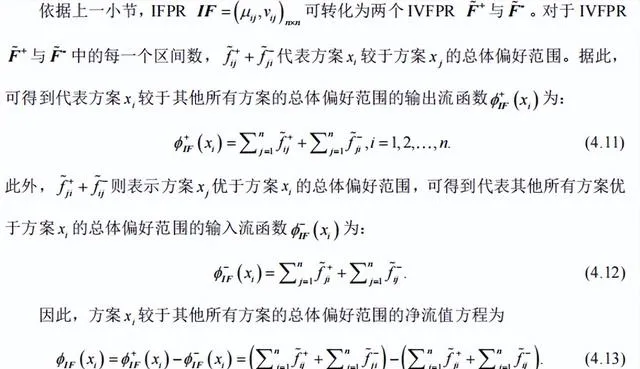
分享兴趣,传播快乐,
增长见闻,留下美好。
亲爱的您,这里是LearingYard学苑!
今天小编为您带来精读博士论文【广义乘性偏好信息下考虑专家共识的多属性群决策方法】4.2直觉偏好关系的净流值方程。
欢迎您的访问!
Share interest, spread happiness,
increase knowledge, and leave beautiful.
Dear, this is the LearingYard Academy!
Today, the editor brings the "4.2 net flow equation for intuitive preference relationships of the intensively read PhD thesis 'A Multi-Attribute Group Decision-Making approach considering expert consensus under generalised nultiplicative preference information'".
Welcome to visit!
一、内容摘要(Summary of Content)
本期推文将从思维导图、精读内容、知识补充三个方面介绍精读博士论文【广义乘性偏好信息下考虑专家共识的多属性群决策方法】的4.2直觉偏好关系的净流值方程。
This tweet will introduce the 4.2 net flow equation for intuitive preference relationships of the intensively read PhD thesis "A Multi-Attribute Group Decision-Making approach considering expert consensus under generalised nultiplicative preference information" in terms of mind mapping, intensive reading content, and knowledge supplementation.
二、思维导图(Mind Maps)

三、精读内容(Intensive reading content)
有学者提出了IFPR(直觉模糊偏好关系)与IVFPR(为区间模糊偏好关系)之间的转化关系,在本章中引入这种转化关系以获取IFPR的净流值方程。此外,本节将IMPR(直觉乘性偏好关系)转化为IVMPR(区间乘性偏好关系),并在此基础上分别提出基于净流值方程的IFPR与IMPR的优先权重确定方法。
Some scholars proposed the transformation relationship between IFPR (intuitive fuzzy preference relation) and IVFPR (interval fuzzy preference relation), and introduced this transformation relationship in this chapter to obtain the net flow value equation of IFPR. In addition, this p transforms IMPR (intuitive multiplicative preference relation) into IVMPR (interval multiplicative preference relation), and on this basis, proposes the method of determining the priority weights of IFPR and IMPR based on the net flow value equation respectively.
(一)直觉模糊偏好关系与区间模糊偏好关系的转化方法( The transformation method of intuitionistic fuzzy preference relation and interval fuzzy preference relation)
作者首先介绍了直觉模糊偏好关系与区间模糊偏好关系的转化方法,具体如下所示。
The author first introduces the transformation method of intuitionistic fuzzy preference relation and interval fuzzy preference relation, as shown below.

(二)直觉乘性偏好关系与区间乘性偏好关系的转化方法( The transformation method of intuitive multiplicative preference relation and interval multiplicative preference relation)
在该部分,作者首先介绍了直觉乘性偏好关系与区间乘性偏好关系的转化方法,如下图所示。
In this part, the author first introduces the transformation method of intuitive multiplicative preference relationship and interval multiplicative preference relationship, as shown in the figure below.

根据以上转换,可以得到如下命题。
According to the above transformation, the following proposition can be obtained.

(三)两种偏好关系的净流值方程(The net flow value equation of the two preference relationships)
有学者分别提出了FPR(模糊偏好关系)与MPR(乘性偏好关系)的输入流与输出流函数,并构建基于净流值理论的FPR与MPR共存的混合偏好信息下的MAGDM(多属性群决策)方法。受上述文献启发,本章提出IFPR与IMPR的净流值方程,并运用到后续研究之中。
Some scholars proposed input and output stream functions of FPR (fuzzy preference relation) and MPR (multiplicative preference relation) respectively, and constructed MAGDM (multi-attribute group decision making) method based on net current value theory under mixed preference information co-existing FPR and MPR. Inspired by the above literature, this chapter puts forward the net flow value equation of IFPR and IMPR, and applies it to the subsequent research.
在该部分,作者根据第一小节的方法推导,推出了IVFPR(为区间模糊偏好关系)中代表方案较于其他所有方案的总体偏好范围的输出流函数和输入流方程,如下图所示。
In this part, according to the method derived in p 1, the author deduced the output flow function and input flow equation representing the overall preference range of the scheme compared with all other schemes in IVFPR (interval fuzzy preference relation), as shown in the figure below.

类似地,也可以得到IVMPR(区间乘性偏好关系)的净流值方程。
Similarly, the net flow value equation of the IVMPR (interval multiplicative preference relation) can also be obtained.

四、知识补充——净流值(Knowledge replenishment - net flow value)
净现值指未来资金(现金)流入(收入)现值与未来资金(现金)流出(支出)现值的差额,是项目评估中净现值法的基本指标。未来的资金流入与资金流出均按预计折现率各个时期的现值系数换算为现值后,再确定其净现值。这种预计折现率是按企业的最低的投资收益率来确定的.是企业投资可以接受的最低界限。
Net present value refers to the difference between the present value of future capital (cash) inflow (income) and the present value of future capital (cash) outflow (expenditure), which is the basic index of the net present value method in project evaluation. The future capital inflow and capital outflow are converted to the present value according to the present value coefficient of each period of the estimated discount rate, and then the net present value is determined. This projected discount rate is determined according to the lowest return on investment of the enterprise. Is the lowest acceptable level of corporate investment.
净流值的采纳法则为在只有一个备选方案的采纳与否决决策中,净现值为正者则采纳,净现值为负者不采纳。在有多个备选方案的互斥选择决策中,应选用净现值是正值中的最大者。
The adoption rule of net current value is that in the adoption and rejection decision of only one alternative, those with positive net present value will adopt, and those with negative net present value will not adopt. In mutually exclusive choice decisions with multiple alternatives, the one with the largest positive net present value should be chosen.
今天的分享就到这里了,
如果您对文章有独特的想法,
欢迎给我们留言。
让我们相约明天,
祝您今天过得开心快乐!
That's all for today's sharing.
If you have a unique idea about the article,
please leave us a message,
and let us meet tomorrow.
I wish you a nice day!
参考资料:谷歌翻译、百度百科
参考文献:
王睿. 广义乘性偏好信息下考虑专家共识的多属性群决策方法 [D]. 四川: 西南交通大学, 2022.
本文由LearningYard学苑整理并发出,如有侵权请在后台留言!
文案| Ann
排版| Ann
审核| Zheng











